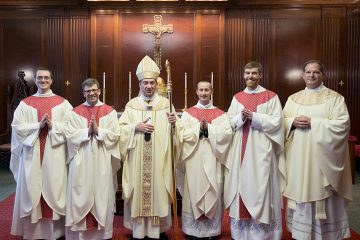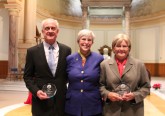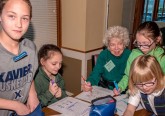Senior communities offer lifestyles to meet needs
Monday, August 9, 2010
By David Eck
ARCHDIOCESE — From maintenance-free cottages for independent seniors to skilled nursing care, senior living communities offer older adults a variety of lifestyles to accommodate their specific needs.
Some senior communities offer cottage or garden-type individual homes. Targeted to active people as young as age 55 who may not yet be retired and need no assistance, the cottages represent an initial level of senior living. Cottage residents who are retired tend to travel, spend winters in warmer climates, volunteer or get involved in recreational activities.
The cottages feature two or three bedrooms and garages. Most also have an emergency call system if residents need help. Residents in cottages typically have priority access to more advanced care sites in the living community should their needs change. Cottages usually require entrance and monthly fees that may or may not include utilities.
 |
| Cottages at Bayley Place, a senior living community in Cincinnati, offer active seniors maintenance-free independent living. (Courtesy photo) |
“Part of being in the cottages is an automatic membership in the fitness club,” said Judy Marx, a social worker and admission counselor at Bayley Place, a senior living community in Cincinnati sponsored by the Sisters of Charity. “So many of the [residents] are active. It’s wonderful to see how vibrant they are, how welcoming they are to the new people coming in.”
Independent living is also available in apartments at some communities. Some apartments are for seniors with restricted incomes.
As residents age and their health declines, they may need some assistance to maintain their independence. Senior living communities provide that support in assisted living apartments. Such assistance could include help with dressing, bathing or medications. Sometimes residents simply need monitoring to stay safe.
“It’s a very natural progression. Their needs have changed,” Marx said. “In our assisted living environment everyone gets three meals a day and weekly housekeeping. For some of our residents that’s the only help they’re getting.”
There is also the peace of mind that assistance is available around the clock.
As the aging process continues and more assistance is required, discussions are held to determine the eventual need for full nursing care.
“[Residents] can be in the assisted living environment and, as their needs change, we can start providing services to them when they need it,” Marx said. “Most people really want to do as much for themselves as they can.”
An important aspect of senior living is the socialization available to all residents. Activities help keep residents physically fit and mentally sharp. Most communities schedule dozens of activities each week, ranging from outings to parties.
“At least every day there are six to seven activities,” said Carmelite Sister Norah Michael McNamara, administrator of St. Margaret Hall in Cincinnati. A Carmelite Sister visits one-on-one with those who don’t wish to participate in the group events so no one is left out.
Regardless of the environment, senior living communities meet the resident at their highest level of functioning.
“We want to emphasize the life,” said Kelly Martin, director of marketing for Mercy Health Partners, which owns six continuing care communities and two independent living communities. “Just because you are in a ‘nursing home’ doesn’t mean that it’s knocking on death’s door.”
“We have people at all different levels of functioning and our goal is always to maximize a resident’s independence as long as possible,” Martin said. “As much as they can do for themselves, we want them to remain able to do that.”
David Eck can be reached at [email protected].











